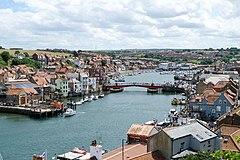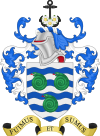| Whitby | |
|---|---|
| Town | |
 View of Whitby from the West Cliff | |
 | |
Location within North Yorkshire | |
| Population | 13,213 (2011 census)[1] |
| OS grid reference | NZ893109 |
| Civil parish |
|
| Unitary authority | |
| Ceremonial county | |
| Region | |
| Country | England |
| Sovereign state | United Kingdom |
| Post town | WHITBY |
| Postcode district | YO21, YO22 |
| Dialling code | 01947 |
| Police | North Yorkshire |
| Fire | North Yorkshire |
| Ambulance | Yorkshire |
| UK Parliament | |
Whitby is a seaside town, port and civil parish in North Yorkshire, England. It is on the Yorkshire Coast at the mouth of the River Esk. It has a maritime, mineral and tourist economy. The fishing port emerged during the Middle Ages, supporting important herring and whaling fleets,[2][3] and was where Captain Cook learned seamanship and, coincidentally, where his first vessel to explore the southern ocean, HMS Endeavour, was built.[4] Jet and alum were mined locally, and Whitby jet, which was mined by the Romans and Victorians, became fashionable during the 19th century.
The earliest record of a permanent settlement is in 656 AD, when as Streanæshealh it was the place where Oswy, the Christian king of Northumbria, founded the first abbey, under the abbess Hilda. The Synod of Whitby was held there in 664 AD. In 867 AD, Viking raiders destroyed the monastery. The town's East Cliff is home to the ruins of Whitby Abbey, where Cædmon, the earliest recognised English poet, lived. Another monastery was founded in 1078 AD. It was in this period that it gained its current name, Whitby (from "white settlement" in Old Norse). In the following centuries Whitby functioned as a fishing settlement until, in the 18th century, it developed as a port and centre for shipbuilding and whaling, the trade in locally mined alum, and the manufacture of Whitby jet jewellery. Tourism started in Whitby during the Georgian period and developed with the arrival of the railway in 1839.
Whitby's attraction as a tourist destination is enhanced by the nearby high ground of the North York Moors national park and the heritage coastline and by association with the horror novel Dracula. The abbey ruin at the top of the East Cliff is the town's oldest and most prominent landmark. Other significant features include the swing bridge, which crosses the River Esk and the harbour, which is sheltered by the grade II listed East and West piers. Its maritime heritage is commemorated by statues of the explorer Captain Cook and the whaler and scientist William Scoresby, as well as the whalebone arch that sits at the top of the West Cliff. It also has a strong literary tradition and has featured in literary works, television and cinema, most famously in Bram Stoker's novel Dracula.
While Whitby's cultural and historical heritage contribute to the local economy, it is financially constrained by its remote location, ongoing changes in the fishing industry, relatively underdeveloped transport infrastructure and limitations on available land and property. As a result, tourism and some forms of fishing remain the mainstay of its economy. It is the closest port to a proposed wind farm development in the North Sea, 47 miles (76 km) from York and 22 miles (35 km) from Middlesbrough. There are transport links to the rest of North Yorkshire and North East England, primarily through national rail links to Middlesbrough and road links to Teesside, via both the A171 and A174, and Scarborough by the former. As at 2011, the town had a population of 13,213.[1]
- ^ a b UK Census (2011). "Local Area Report – Whitby Parish (1170217370)". Nomis. Office for National Statistics. Retrieved 21 March 2018.
- ^ "BLESSING THE HERRING FLEET – British Pathe". britishpathe.com. 2011. Archived from the original on 29 July 2012. Retrieved 20 October 2011.
- ^ "Whaling in Whitby – Whitby Online". whitbyonline.co.uk. 2011. Archived from the original on 6 March 2016. Retrieved 20 October 2011.
- ^ Hough 1994, p. 55
